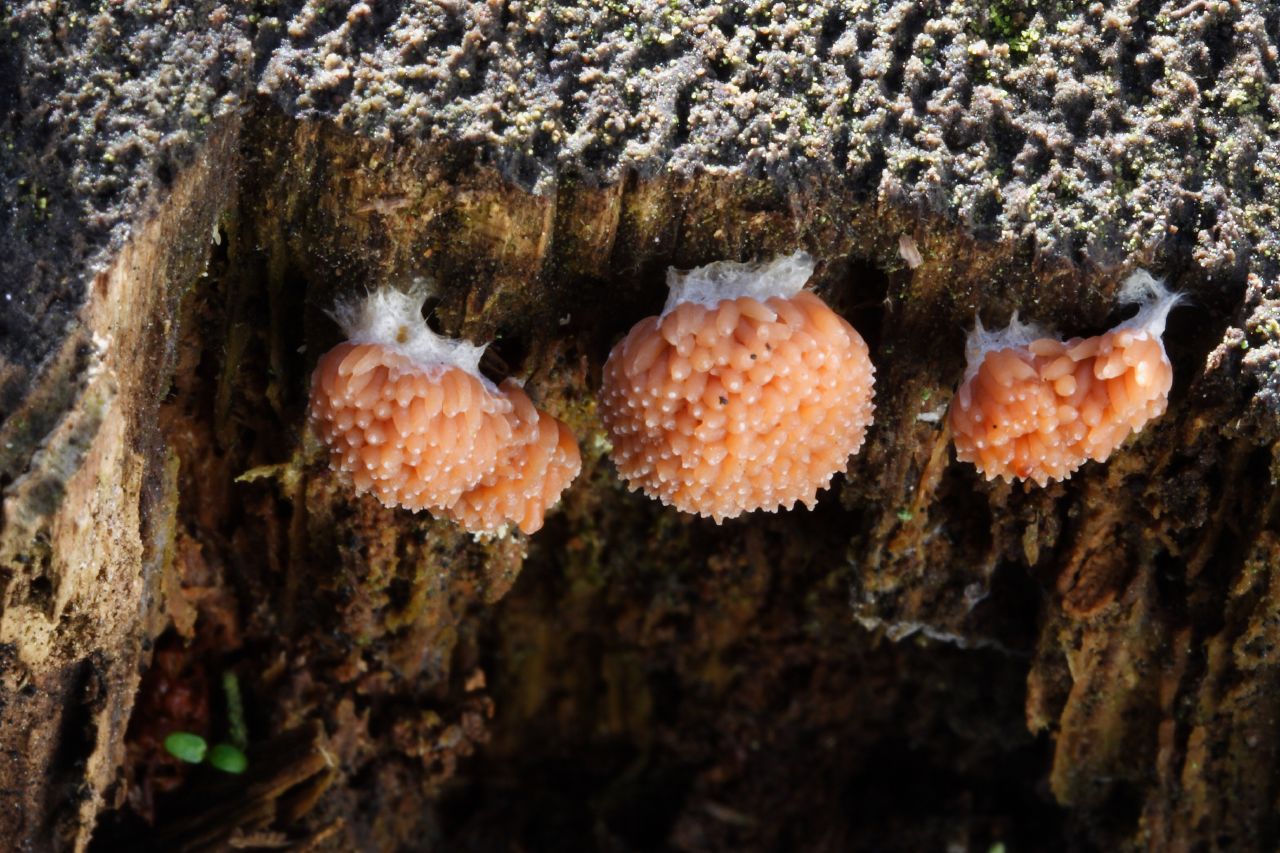Hypothallus on:
[Wikipedia]
[Google]
[Amazon]
 In true
In true
 In true
In true slime mold
Slime mold or slime mould is an informal name given to several kinds of unrelated eukaryotic organisms with a life cycle that includes a free-living single-celled stage and the formation of spores. Spores are often produced in macroscopic mul ...
s (myxogastria
Myxogastria/Myxogastrea (myxogastrids, ICZN) or Myxomycetes ( ICN), is a class of slime molds that contains 5 orders, 14 families, 62 genera, and 888 species. They are colloquially known as the ''plasmodial'' or ''acellular ...
), lichens, and in species of the family Clavicipitaceae
The Clavicipitaceae are a family of fungi within the order Hypocreales. A 2008 estimate placed 43 genera in the family, but recent work has increased this number to 97.
Phylogeny
Molecular phylogenetic analysis of multigene DNA sequence data in ...
, the hypothallus is the layer on which the fruit body sits, lying in contact with the substrate. The word is derived from the Ancient Greek
Ancient Greek includes the forms of the Greek language used in ancient Greece and the ancient world from around 1500 BC to 300 BC. It is often roughly divided into the following periods: Mycenaean Greek (), Dark Ages (), the Archaic p ...
root ''hypó'' ("under") and ''thallós'' ("shoot" or "thallus
Thallus (plural: thalli), from Latinized Greek (), meaning "a green shoot" or "twig", is the vegetative tissue of some organisms in diverse groups such as algae, fungi, some liverworts, lichens, and the Myxogastria. Many of these organisms ...
").
The hypothallus is produced by the plasmodium
''Plasmodium'' is a genus of unicellular eukaryotes that are obligate parasites of vertebrates and insects. The life cycles of ''Plasmodium'' species involve development in a blood-feeding insect host which then injects parasites into a ver ...
at the beginning of fructification. Depending on the species, it can be membranous to thick or tender to solid and nearly transparent to brightly coloured. It may surround an individual fruit body, or may form a contiguous connection between multiple fruit bodies. In some rare cases it is missing entirely.
In crustose lichen
Crustose lichens are lichens that form a crust which strongly adheres to the substrate (soil, rock, tree bark, etc.), making separation from the substrate impossible without destruction. The basic structure of crustose lichens consists of a cor ...
s, the hypothallus is the blackish lower layer of the thallus that produces rhizine
In lichens, rhizines are multicellular root-like structures, arising mostly from the lower surface. A lichen with rhizines is termed rhizinate, while a lichen lacking rhizines is termed erhizinate. Rhizines serve only to anchor the lichen to their ...
s, which are holdfasts that attach the lichen to its substrate.
In some taxa
In biology, a taxon (back-formation from ''taxonomy''; plural taxa) is a group of one or more populations of an organism or organisms seen by taxonomists to form a unit. Although neither is required, a taxon is usually known by a particular nam ...
the hypothallus may be involved in the formation of the fruit body. In the "epihypothallic" Stemonitida
Stemonitidales is an order of Amoebozoan slime mold
Slime mold or slime mould is an informal name given to several kinds of unrelated eukaryotic organisms with a life cycle that includes a free-living single-celled stage and the formation ...
, the hypothallus forms hollow, tubular stems and a columella
Lucius Junius Moderatus Columella (; Arabic: , 4 – ) was a prominent writer on agriculture in the Roman Empire.
His ' in twelve volumes has been completely preserved and forms an important source on Roman agriculture, together with the wo ...
, up which the remaining plasmodium then rises, producing the spores. In all other myxogastria "subhypothallic" development takes place. Here, the hypothallus produces a layer on the plasmodium, which creates the rooms of the single fruit bodies during fructification. As the surrounding plasmodium flows in the fruit body, the hypothallus will lie directly on the substrate, shrinking and creating the edge of the mature fruit body. Here, the hypothallus is part of a morphological unit with peridium and stem, which serves as a membranous surface of the whole structure with the spores. Epihypothaly is an autapomorphy
In phylogenetics, an autapomorphy is a distinctive feature, known as a derived trait, that is unique to a given taxon. That is, it is found only in one taxon, but not found in any others or outgroup taxa, not even those most closely related to ...
of the stemonitida and is, in comparison to subhypothaly, a primitive feature.
References
{{Reflist, colwidth=30em, , refs= Reference for the paragraph: Henry Stempen, Steven L. Stevenson: Myxomycetes. A Handbook of Slime Molds. Timber Press, 1994, {{ISBN, 0-88192-439-3, p. 26. A.-M. Fiore-Donno, C. Berney, J. Pawlowski, S.L. Baldauf: ''Higher-Order Phylogeny of Plasmodial Slime Molds (Myxogastria) Based on Elongation Factor 1-A and Small Subunit rRNA Gene Sequences.'' In: Journal of Eukaryotic Microbiology, 52, pp. 201–210, 2005 Reference for the paragraph: A.-M. Fiore-Donno, C. Berney, J. Pawlowski, S.L. Baldauf: ''Higher-Order Phylogeny of Plasmodial Slime Molds (Myxogastria) Based on Elongation Factor 1-A and Small Subunit rRNA Gene Sequences.'' In: Journal of Eukaryotic Microbiology, 52, pp. 201–210, 2005 Reference for the paragraph: Wolfgang Nowotny: ''Myxomyceten (Schleimpilze) und Mycetozoa (Pilztiere) - Lebensformen zwischen Tier und Pflanze'' In: {{ISBN, 3854740565, pp. 7–37. Wolfgang Nowotny: ''Myxomyceten (Schleimpilze) und Mycetozoa (Pilztiere) - Lebensformen zwischen Tier und Pflanze'' In: {{ISBN, 3854740565, pp. 7–37. {{cite book , author1=Ulloa, Miguel , author2=Halin, Richard T. , title=Illustrated Dictionary of Mycology , edition=2nd , year=2012 , publisher=The American Phytopathological Society , location=St. Paul, Minnesota , isbn=978-0-89054-400-6 , page=296 Fungal morphology and anatomy Cell biology